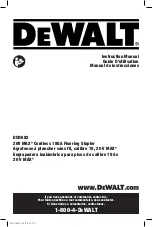
ENglISh
4
body of the tool or top cap as a hammer. Discharged
fasteners may follow unexpected path and
cause injury.
•
Always keep fingers clear of contact trip to prevent
injury from inadvertent release of the pusher
(Fig. H)
•
Refer to the
Maintenance
and
Repairs
sections for
detailed information on the proper maintenance of
the tool.
•
Always operate the tool in a clean, lighted area.
Be sure the work surface is clear of any debris and be
careful not to lose footing when working in elevated
environments such as rooftops.
•
Do not drive fasteners near edge of material.
The
workpiece may split causing the fastener to ricochet,
injuring you or a co-worker. Be aware that the nail
may follow the grain of the wood (shiner), causing it to
protrude unexpectedly from the side of the work material.
Drive the chisel point of the nail perpendicular to the grain
to reduce risk of injury.
•
Do not drive nails onto the heads of other fasteners
or with the tool at too steep an angle.
Personal injury
from strong recoil, jammed fasteners, or ricocheted nails
may result.
•
Keep hands and body parts clear of immediate work
area.
Hold workpiece with clamps when necessary to
keep hands and body out of potential harm. Be sure the
workpiece is properly secured before pressing the nailer
against the material. The contact trip may cause the work
material to shift unexpectedly.
•
Do not use tool in the presence of flammable dust,
gases or fumes.
The tool may produce a spark that could
ignite gases causing a fire. Driving a nail into another nail
may also cause a spark.
•
Keep face and body parts away from back of the tool
cap when working in restricted areas.
Sudden recoil
can result in impact to the body, especially when nailing
into hard or dense material.
•
Grip tool firmly to maintain control while allowing
tool to recoil away from work surface as fastener
is driven.
In Bump mode if contact trip is allowed to
recontact work surface before trigger is released an
unwanted fastener will be fired.
•
Choice of triggering method is important.
Check the
manual for triggering options
Sequential/Bump Selector Switch
Sequential Action
•
When using the tool in sequential mode mode, do
not actuate the tool unless the tool is placed firmly
against the workpiece.
Bump Action
•
When using the tool in bump action, be careful of
unin tentional double fires resulting from tool recoil.
Unwanted fasteners may be driven if the contact trip is
allowed to accidentally re-contact the work surface.
•
To Avoid Double Fires:
ʵ Do not engage the tool against the work surface with
a strong force.
ʵ Allow the tool to recoil fully after each actuation.
ʵ Use tool in sequential mode.
•
When “bump” actuating the finish nailer, always
keep tool in control.
Inaccurate placement of tool can
result in misdirected discharge of a fastener.
•
Do not drive nails onto the heads of other fasteners.
Strong recoil, jammed fasteners, or ricocheted nails
may result.
•
Be aware of material thickness when using nailer.
A
protruding nail may cause injury.
•
Depth adjustment: To reduce risk of serious injury
from accidental actuation when attempting to
adjust depth, ALWAYS;
ʵ Remove battery pack.
ʵ Engage trigger lock.
ʵ Avoid contact with trigger during adjustments.
•
Do not drive nails blindly into walls, floors or other
work areas.
Fasteners driven into live electrical wires,
plumbing, or other types of obstructions can result
in injury.
•
Stay alert, watch what you are doing and use
common sense when operating a power tool. Do not
use tool while tired or under the influence of drugs,
alcohol, or medication.
A moment of inattention
while operating power tools may result in serious
personal injury.
Additional Safety Information
WARNING: ALWAYS
use safety glasses. Everyday
eyeglasses are NOT safety glasses. Also use face or
dust mask if cutting operation is dusty. ALWAYS WEAR
CERTIFIED SAFETY EQUIPMENT:
• ANSI Z87.1 eye protection (CAN/CSA Z94.3),
• ANSI S12.6 (S3.19) hearing protection,
• NIOSH/OSHA/MSHA respiratory protection.
WARNING:
Some dust created by power sanding,
sawing, grinding, drilling, and other construction
activities contains chemicals known to the State
of California to cause cancer, birth defects or
other reproductive harm. Some examples of these
chemicals are:
• lead from lead-based paints,
• crystalline silica from bricks and cement and other
masonry products, and
• arsenic and chromium from chemically-
treated lumber.
Your risk from these exposures varies, depending on how
often you do this type of work. To reduce your exposure to
these chemicals: work in a well ventilated area, and work with
approved safety equipment, such as those dust masks that are
specially designed to filter out microscopic particles.
•
Avoid prolonged contact with dust from power
sanding, sawing, grinding, drilling, and other







































